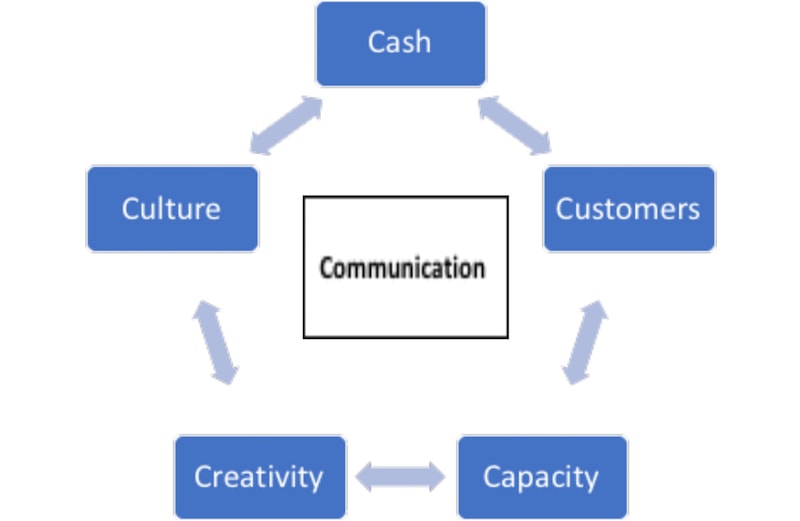“Never waste a good crisis.”
–attributed to Anne Harbison, Machiavelli, and others
It is very weird driving anywhere during this crisis and seeing many businesses closed. This reminds me of growing up in a small town when Sunday was for church, family visiting, and great dinners (the Sunday dinners is a tradition we’ve continued). Otherwise, everything was closed on Sunday.
Whether your business is deemed essential or discretionary, you have value to offer to your customers and clients. As fewer people are out conducting their regular business, both types of businesses need specific strategies and tactics to protect themselves in the short-term. Both need to be prepared to get up to speed quickly when things return to normal, or a new normal, which they eventually will.
Operating in a crisis is similar to operating in a turnaround situation. From my experience helping companies get back on their feet after management made bad decisions or customer failure forced hardship on them, I’ve put together this six-point plan. I call it the Six Cs of Crisis Management.
The Six Cs of Business Crisis Management
Figure 57.1 Six Cs of Business Crisis Management

- Cash
Repeat after me: “Cash isn’t king, it’s the ace!”
Ever since I can remember, financial planners have been advising their personal clients to have three to six months of operating expenses as readily available cash. This is much tougher for many businesses, especially if you are (or were) in a high growth mode. But the logic and wisdom apply.
High growth burns through cash just like a rocket burns through fuel: it needs to get into orbit where its momentum will sustain movement.
This is the time to hoard cash by asking customers to pay you more quickly, taking deposits on orders, offering discounts to get paid in advance, switching loan payments to interest only, and asking suppliers for extended payment terms.
- Customers
According to Peter Drucker, the father of management consulting, the purpose of a business is to serve its customer.
All customers are not created equally. The customer that grinds you on price and then takes forever to pay you is much better off with your competitor than with you.
Rank your customers into “A, B, C, or D” categories by assessing their profitability, pleasure to deal with, referrals, and lifetime value. Be highly proactive with your A and B customers. Raise prices and implement stricter terms with C customers. D customers can’t stay; they’re not worth it.
“D” customers should be fired or turned into “B” customers by raising their prices and improving how they conduct business with you.
Most importantly, take care of your customers, especially the best ones.
- Capacity
A manufacturing company will have high variable costs related to production, such as direct labor and raw materials. The overheads still need to be paid regardless how busy or idle the plant is on any day.
Many other businesses, such as service businesses, have very high fixed overheads as they must pay most people whether they are productive or not.
The key for any type of business is to maximize your utilization of your existing people, equipment, and assets.
If you have much more capacity than demand from customers, then I recommend that you reduce your capacity and overheads to match expected or actual demand. Profit doesn’t occur by accident.
- Creativity
Our survival as a species is based on our ability to adapt, according to Darwin. When we can’t do things the way we did before, we need to innovate. There is no time like the present to pivot and develop new business models, new offerings, and new products and services.
It’s amazing that it will take a global pandemic for some people to have a new idea. However, most entrepreneurs are constantly coming up with new ideas. These businesses will surely thrive in challenging times.
- Culture
Culture is about the behaviours, and the beliefs behind those behaviours, that your employees exemplify at work. Usually, culture is based on the founder’s values, however positive or negative they may be.
People will pursue rewards and avoid punishment.
- How would you describe your culture?
- How are your leaders encouraging behaviour that aligns with your strategy and positive values?
Central to the Six Cs is communication.
- Communication
Whenever I speak with any manager or employee, they will eventually offer up that the number one problem with leadership is communication. Either there is too much information (rarely) or not enough information (99% of the time).
I always say that you can’t hold someone accountable for something unless they have the information and resources needed to perform their jobs. What information do your employees—and leaders—need to do their jobs effectively?
It’s also very common for many business owners to be reluctant to disclose financial information with employees. What ends up happening is that the employees over-estimate the business performance and profitability and end up not trying as hard at work. Sharing financial information and teaching others how to use it will have very significant benefits on business performance.
In fact, the best performing companies that I’ve worked with share financial information and have specific budget targets such as gross profit and EBITDA that effectively align decision making and actions with business goals.
Communication increases alignment, it enhances culture, and improves overall business performance.
Until your employees are literally mocking you in the halls (in a nice way), you’re not communicating enough.

